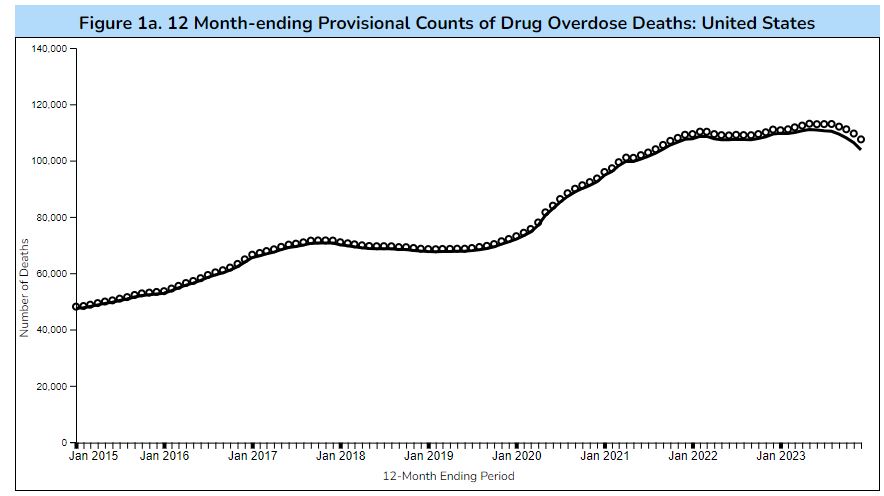Drug overdose deaths are down 3.1% nationwide according to the latest figures from the CDC. 107,543 people died of drug overdoses in 2023 down from 111,029 in 2022.

Here in Connecticut, drug overdose deaths have been decreasing for the last two years (down 14% in 2023 from the 2021 high). Preliminary data I have seen from the first four months of 2024 suggests they are on pace to fall another 4%. That the national rate is behind Connecticut’s doesn’t surprise me as Connecticut and many of the eastern states were the ones showing the greatest rise as fentanyl was mixed with the east Coast powder. A few years later, dealers recognizing the economic benefits of fentanyl over heroin, started flooding the west coast with pressed fentanyl pills as an alternative to the black tar heroin traditionally used in the west, a harder substance to mix fentanyl into than the east coast powder. Deaths continue to rise in most states west of the Mississippi. I would expect their rises to slow and then decline in the next several years to match the East Coast decline.

This is good news that the deaths are starting to go down, but there is no time for celebration as the peak was so extraordinarily high, and another 100,000 Americans will likely die of overdose death this year.
Why are deaths dropping? I can offer these possible answers.
- Harm reduction and the availability of naloxone. Ten years ago when I responded to an overdose, I was the only one carrying naloxone. Now, half the time I arrive, the patient is already awake and talking, having gotten their naloxone either from family, bystander, or police or fire first responders. This doesn’t include all those resuscitations where bystanders gave naloxone and 911 was never called. An unknown, but likely high number.
- An increase in treatment such as buprenorphine and methadone, which have been proven to save lives and get people off the more dangerous heroin and fentanyl. I don’t know the numbers, but I know they are increasing. I also know they are still way too few to meet the demand.
- Dealers, recognizing the difficulty of properly mixing fentanyl so it isn’t too lethal, have begun cutting fentanyl with cheaper, less deadly drugs like xylazine.
- Decline in prescribing. Fewer people are getting hooked by their family doctors, and thus fewer to add to the pool at risk for death.
- The recognition of fentanyl’s lethality and the impact of the death of friends and loved ones may keep people from experimenting to the degrees they might otherwise have.
There may be other reasons that aren’t yet clear. Law enforcement stopping drugs at the border doesn’t seem to be one of them as fentanyl continues to be cheap and widely available, selling here in Connecticut for as little as $2 a bag.
Let’s hope the downward decline not only continues, but accelerates. Let’s get more naloxone on the streets, increase treatment options, fight against stigma and promote harm reduction initiatives such as overdose prevention sites.
Graphics from CDC
